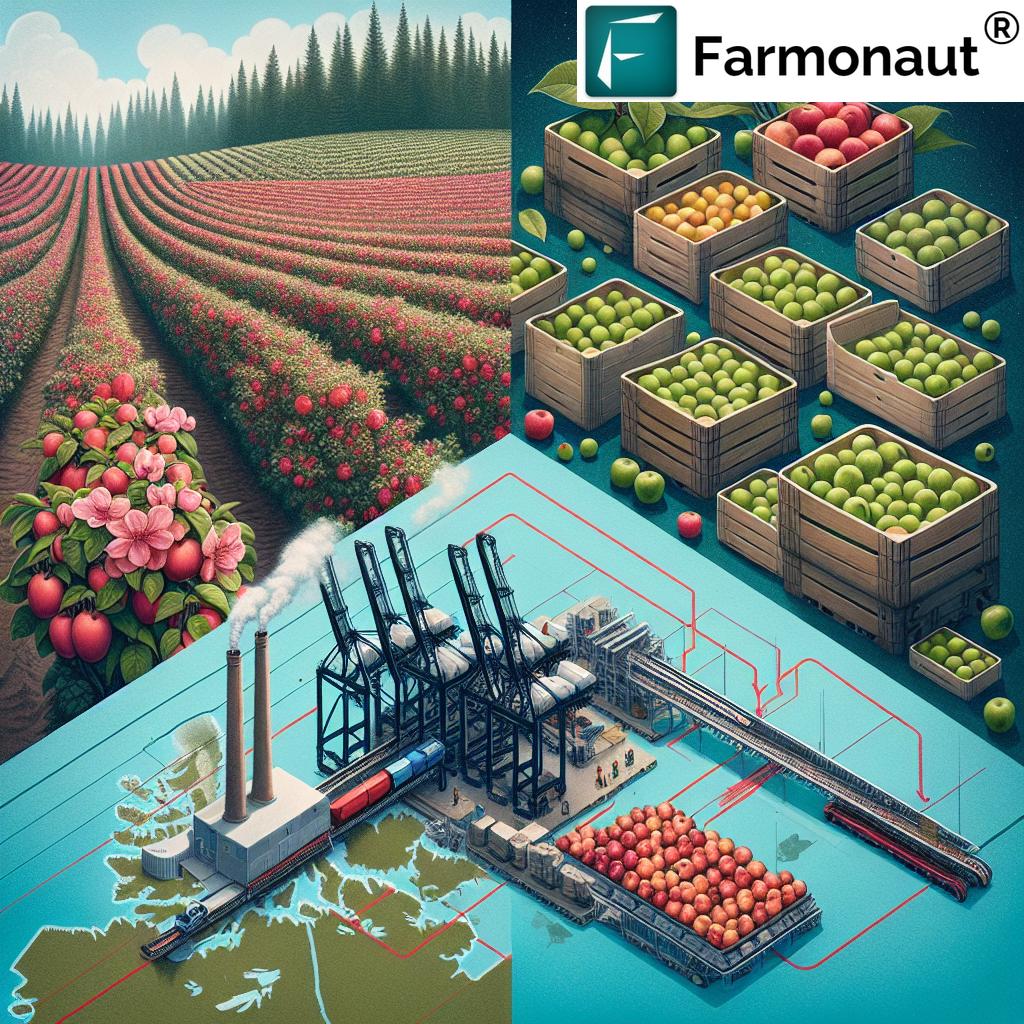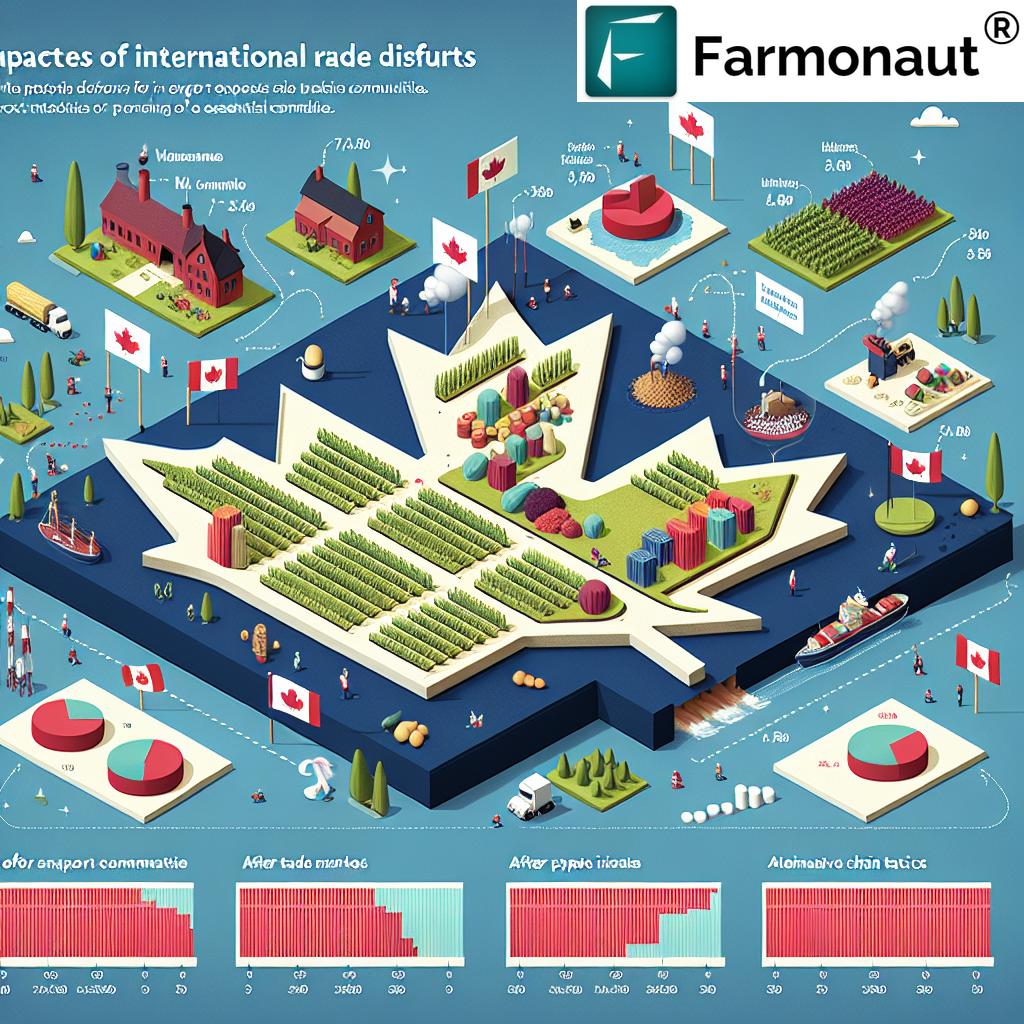Canadian Tariff Retaliation: Impact on Agricultural Exports and Global Trade Relations
“Canadian retaliatory tariffs will impact $155 billion worth of US exports, focusing on agricultural products.”
In the ever-evolving landscape of international trade, we find ourselves at a critical juncture as Canada takes decisive action in response to US-imposed duties. This blog post delves into the far-reaching implications of Canadian retaliatory tariffs on agricultural exports and global trade relations. As we navigate through this complex issue, we’ll explore how these measures are reshaping supply chains, regional economies, and export taxes on key commodities.

Understanding the Canadian Retaliatory Tariffs
In a bold move that has sent shockwaves through the global trade community, Canada has announced plans to implement retaliatory tariffs on a significant amount of U.S. exports. This decision comes as a direct response to new tariffs imposed by the United States, marking a critical escalation in the US-Canada trade dispute. Let’s break down the key aspects of Canada’s response to US tariffs:
- Prime Minister Justin Trudeau has unveiled plans to introduce 25% tariffs on approximately $155 billion worth of U.S. goods.
- An initial $30 billion of these tariffs is set to take effect shortly.
- The broader measures will be enacted in three weeks, allowing Canadian businesses and supply chains time to adapt.
This strategic move by Canada demonstrates the country’s commitment to protecting its interests in the face of what it perceives as unfair trade practices. The impact of these tariffs will be felt across various industries, with a particular focus on agricultural products.
Agricultural Products in the Crosshairs
The agricultural sector stands at the forefront of this trade dispute, with several key products targeted by the Canadian retaliatory tariffs. These include:
- Beer and wine
- Bourbon
- Fruits, including orange juice
- Vegetables
While the specific timing of when these agricultural products will be taxed remains unclear, the announcement has already sent ripples through the industry. Farmers and exporters on both sides of the border are bracing for potential disruptions to their businesses.
The Bigger Picture: Beyond Agriculture
While agricultural products are at the forefront of this trade dispute, the implications extend far beyond the farm. The U.S. remains a crucial market for Canadian exports, including oil and potash. Prime Minister Trudeau has hinted at the possibility of introducing export taxes on certain commodities in the future, although he emphasized the importance of not disproportionately impacting any single Canadian industry or region.
This strategic approach highlights the delicate balance Canada must strike in its retaliatory measures. On one hand, the country aims to send a strong message to its southern neighbor. On the other, it must carefully consider the potential repercussions on its own industries and regional economies.
Provincial Responses and Local Initiatives
The impact of these tariffs is not limited to federal policy. Canadian provincial leaders are taking swift action to support the national stance:
- Premier David Eby of British Columbia has announced an immediate prohibition on purchases of American liquor from Republican states.
- Nova Scotia’s Premier Tim Houston has confirmed an identical policy.
- Both provinces are exploring ways to limit U.S. companies’ access to government contracts.
- Nova Scotia is actively seeking opportunities to cancel current agreements with U.S. firms.
These provincial measures demonstrate a coordinated effort across different levels of government to respond to the U.S. tariffs. They also highlight the potential for localized impacts on specific industries and regions within Canada.
Consumer Impact and “Choose Canada” Initiative
In light of these trade tensions, Prime Minister Trudeau has called on Canadian consumers to prioritize local products in their purchasing decisions. This “Choose Canada” initiative encourages citizens to opt for homegrown options over American imports. For example:
- Choosing Canadian rye whiskey instead of Kentucky bourbon
- Avoiding Florida orange juice altogether
This consumer-focused approach aims to bolster domestic industries while sending a message to U.S. producers. However, it also raises questions about potential price increases and product availability for Canadian consumers.

Global Implications: Mexico and China Enter the Fray
“Provincial leaders in Canada are limiting American liquor purchases and government contracts in response to US-imposed duties.”
The trade tensions between Canada and the U.S. are not occurring in isolation. Other major global players are closely watching and considering their own responses:
Mexico’s Response
Under President Claudia Sheinbaum, Mexico is planning its own retaliatory strategy. This includes:
- Developing a plan with both tariff and non-tariff measures
- Potential new duties on U.S. agricultural goods such as pork and cheese
- Emphasis on dialogue over tariffs as a means of addressing trade issues
Mexico’s approach underscores the interconnected nature of North American trade relations and the potential for a broader trade war.
China’s Stance
China has also entered the fray, condemning a recently implemented 10% tariff on U.S. imports from China. The Chinese government has signaled its intent to take reciprocal actions to safeguard its interests, further complicating the global trade landscape.
These developments highlight the potential for a cascading effect in international trade relationships, with actions by one country prompting responses from others in a complex web of economic interdependence.
Impact on Supply Chains and Industry Alternatives
The implementation of these tariffs is set to have significant ramifications for supply chains across various industries. Companies on both sides of the border are now faced with the challenge of adapting to this new trade reality. Some potential impacts and alternatives include:
- Diversification of supply sources to reduce reliance on tariff-affected products
- Exploration of new markets for exports to offset potential losses in the U.S.-Canada trade
- Investment in domestic production capabilities to reduce import dependence
- Increased focus on innovation and efficiency to maintain competitiveness despite higher costs
For industries heavily reliant on cross-border trade, such as agriculture and manufacturing, these changes may necessitate significant operational adjustments. Companies may need to reevaluate their sourcing strategies, logistics operations, and even their product offerings to navigate this new landscape effectively.
The Role of Technology in Adapting to Trade Challenges
In the face of these trade challenges, technology plays a crucial role in helping businesses adapt and thrive. Advanced agricultural technology solutions, such as those offered by Farmonaut, can provide valuable support to farmers and agribusinesses navigating this complex trade environment.
Farmonaut’s satellite-based farm management solutions offer real-time crop health monitoring, AI-based advisory systems, and resource management tools. These technologies can help farmers optimize their operations, potentially offsetting some of the negative impacts of trade tariffs by improving efficiency and productivity.
For example, Farmonaut’s precision agriculture tools can help farmers:
- Make data-driven decisions about crop management
- Reduce input costs through optimized resource use
- Improve crop yields, potentially increasing competitiveness in both domestic and international markets
By leveraging such technologies, agricultural businesses can better position themselves to weather trade-related challenges and explore new opportunities in a changing market landscape.
Comparative Analysis of Canadian Retaliatory Tariffs on US Agricultural Exports
| Product Category | Estimated Annual Export Value to Canada (USD) | Previous Tariff Rate (%) | New Retaliatory Tariff Rate (%) | Projected Impact on Export Volume (% change) |
|---|---|---|---|---|
| Fruits (incl. Orange Juice) | $1.5 billion | 0-5% | 25% | -20% to -30% |
| Vegetables | $2 billion | 0-10% | 25% | -15% to -25% |
| Beer | $300 million | 0% | 25% | -25% to -35% |
| Wine | $450 million | 0-5% | 25% | -20% to -30% |
| Bourbon | $200 million | 0% | 25% | -30% to -40% |
This table provides a clear overview of the potential impact of Canadian retaliatory tariffs on key US agricultural exports. The significant increase in tariff rates across all product categories is likely to result in substantial reductions in export volumes. These changes could have far-reaching consequences for US farmers and producers, potentially leading to shifts in market dynamics and trade patterns.
The Path Forward: Dialogue and Diplomacy
Despite the implementation of these retaliatory measures, there remains hope for a diplomatic resolution to the trade dispute. Prime Minister Trudeau has expressed a willingness to engage in dialogue with the U.S. administration to negotiate away the tariffs. However, he has also noted unsuccessful attempts to connect with the U.S. president since the beginning of his term.
The path forward likely involves a combination of:
- Continued diplomatic efforts at the highest levels of government
- Engagement of industry stakeholders in both countries to advocate for resolution
- Potential involvement of international trade organizations to mediate the dispute
- Exploration of alternative trade agreements or modifications to existing ones
As these efforts unfold, businesses and consumers on both sides of the border will need to remain adaptable and resilient in the face of ongoing uncertainty.
Leveraging Technology for Agricultural Resilience
In these challenging times, technology can play a crucial role in helping agricultural businesses adapt and thrive. Farmonaut’s advanced satellite-based farm management solutions offer valuable tools for farmers and agribusinesses looking to optimize their operations and mitigate the impact of trade disruptions.
Key features of Farmonaut’s platform include:
- Real-time crop health monitoring using satellite imagery
- AI-driven personalized farm advisory through the Jeevn AI system
- Resource management tools for optimizing inputs and reducing costs
- Carbon footprint tracking for sustainability and compliance
By leveraging these technologies, farmers can make data-driven decisions to improve productivity, reduce costs, and potentially offset some of the negative impacts of trade tariffs.
Conclusion: Navigating Uncertain Waters
The implementation of Canadian retaliatory tariffs marks a significant shift in the landscape of international trade relations. As we’ve explored in this blog post, the impact of these measures extends far beyond the immediate agricultural sector, touching on issues of regional economics, global trade dynamics, and diplomatic relations.
Key takeaways include:
- The broad scope of Canadian tariffs, targeting $155 billion worth of US exports
- The specific focus on agricultural products and beverages
- Provincial-level responses complementing federal actions
- The potential for a wider trade war involving Mexico and China
- The crucial role of technology in helping businesses adapt to new trade realities
As this situation continues to evolve, it’s clear that businesses, policymakers, and consumers will need to remain vigilant and adaptable. The use of advanced technologies, such as those offered by Farmonaut, can provide valuable tools for navigating these uncertain waters.
We’ll continue to monitor these developments closely, providing updates and insights as the global trade landscape shifts. In the meantime, businesses would do well to explore all available options for optimizing their operations and diversifying their markets in the face of these new challenges.
FAQ Section
Q: What are the main agricultural products affected by Canadian retaliatory tariffs?
A: The main agricultural products affected include fruits (especially orange juice), vegetables, beer, wine, and bourbon.
Q: How much of US exports will be impacted by these tariffs?
A: Canadian retaliatory tariffs are set to impact approximately $155 billion worth of US exports.
Q: Are Canadian provinces taking any additional measures?
A: Yes, some provinces like British Columbia and Nova Scotia are limiting American liquor purchases and restricting US companies’ access to government contracts.
Q: How might these tariffs affect Canadian consumers?
A: Canadian consumers may see price increases on certain US products and are being encouraged to choose Canadian alternatives where possible.
Q: Are other countries considering similar measures?
A: Yes, both Mexico and China are contemplating their own retaliatory measures in response to US trade policies.
Q: How can agricultural businesses adapt to these changes?
A: Agricultural businesses can adapt by diversifying their markets, optimizing operations, and leveraging technology solutions like those offered by Farmonaut for improved efficiency and productivity.
Earn With Farmonaut: Affiliate Program
Earn 20% recurring commission with Farmonaut’s affiliate program by sharing your promo code and helping farmers save 10%. Onboard 10 Elite farmers monthly to earn a minimum of $148,000 annually—start now and grow your income!







